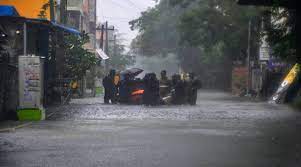New Delhi. The south-west monsoon received more than normal rainfall and it also stayed for a long time. During the four months from June to September, Tamil Nadu received 45% more rainfall than the monsoon. Whereas now the northeast monsoon has knocked in Tamil Nadu. The India Meteorological Department has said that the north-east monsoon rains will start over the Bay of Bengal and South Peninsular India. Rains will continue over many parts of South India for the next several days and possibly even further.
The IMD has forecast scattered to heavy rain and thundershowers across Tamil Nadu from Saturday to next Wednesday (October 29 to November 2). IMD has issued a yellow alert in many places including Tamil Nadu during this period. In an advisory, especially those living in the northern part of the state, residents have been urged to remain ‘alert’ about the local weather conditions. Apart from this, due to the possibility of very heavy rains next week, the IMD’s Regional Meteorological Center in Chennai has issued an orange alert on Monday and Tuesday due to the possibility of inclement weather in Tiruvallur, Kancheepuram and Ranipet districts. Orange alert has also been issued in Vellore and Tiruppattur districts for Tuesday.
According to the IMD, Tamil Nadu receives at least 48% (on average) of its annual rainfall from the northeast monsoon, which usually lasts from October to December. In comparison, only 36 percent of its annual rainfall comes from the southwest monsoon. Therefore, it has a major impact on the state’s agricultural activities and reservoir management. According to the Meteorological Department, on Sunday (October 30), there will be heavy rainfall at isolated places in Tamil Nadu, Puducherry and Karaikal and Kerala and Mahe.
Meanwhile, a fresh Western Disturbance is likely to affect the Western Himalayan region from October 31. Due to this, light to moderate rain may occur in Jammu, Kashmir, Ladakh, Gilgit, Baltistan and Muzaffarabad and Himachal Pradesh from October 31 to November 2. Along with this, the Meteorological Department has predicted both day and night temperatures to be extremely or very high above normal in most parts of Trans Himalaya and Western Himalayas till at least the beginning of November.
 Indian Thought Latest News & Views
Indian Thought Latest News & Views



